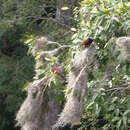en
names in breadcrumbs


Perception Channels: visual ; tactile ; acoustic ; chemical
Oropendolas are not endangered, therefore, they have no special status. However, the rainforests in which they live have been diminishing. Trees are cut down every day because of human development. It is fortunate that they adapt well to open country where scattered trees still remain to provide food and homes (Skutch 1996; Jaramillo and Burke 1999).
US Federal List: no special status
CITES: no special status
IUCN Red List of Threatened Species: least concern
They do not have any negative impacts on humans. Although confident in their own colonies, they tend to shy away in the presence of humans (Skutch 1996).
The bright yellow and chestnut brown feathers are used in the indigenous cultures of the Amazon rainforests as ornamentation. While they are worn for ceremonial occasions, they do not carry religious significance (American Museum of Natural History, 2000).
Psarocolius montezuma are also popular among bird watchers. They are great for sighting because of their colorful appearance and loud calls (Skutch 1996).
Montezuma Oropendolas are primarily fruit eaters. They have also been known to eat flowers from the surface of open grasslands, larger insects, and grass clumps of organic material. Females forage for food away from the colony in groups while males tend to search alone. They will eat throughout the day, but end their searches before dark (Orians 1985; Kraucunas 1996).
Psarocolius montezuma are found in southern Mexico to central Panama. Because the land is high and broad on the Pacific coast, they are restricted to the Caribbean side in Guatemala and southern Costa Rica. In northern Costa Rica, they are found on the Pacific slope for the same reason (Skutch 1996).
Biogeographic Regions: neotropical (Native )
Montezuma Oropendolas live in the rainforest regions near water and clearings, but not too deep in the forest. These birds can be found close to banana plantations and bamboo thickets. Tall, wide dicotyledonous trees are usually chosen, but they have been seen in a variety of trees if there is an absence of dicotyledonous trees (Skutch 1996; Jaramillo and Burke 1999).
Terrestrial Biomes: savanna or grassland ; rainforest
A large bird compared to other oropendolas, Psarocolius montezuma are very visible because of their bright colors. Males and females are mostly deep chestnut in color, except for shades of yellow on their outer tail feathers and a black head complete with a pale, blue patch of skin and pink wattle. Their sharp bills are black and orange, and in males, the orange extends over their forehead. Males also have extra skin on either side of their chin and are considereably larger than females, which accounts for the wide ranges of mass. An adult male can grow to 51 cm in length, while females are 38cm in length on average. Juveniles are similar to adults except the colors are duller and they are smaller in size (Skutch 1996; Jaramillo and Burke 1999).
Range mass: 230 to 520 g.
Other Physical Features: endothermic ; bilateral symmetry
Mating season is from January to May. Females, alone, incubate around 1-2 eggs at a time. After incubation, which can last around 15 days, the eggs hatch. Fledging occurs 15 days after hatching. A juvenile reaches sexual maturity in less than 1 month, but will not mate until the following year. The mortality rate is high in oropendolas because depredation occurs often by toucans, snakes, monkeys, and botfly larvae. Females will mate up to three times during the season, but less than one half percent of the chicks live past hatching (Kraucunas 1996; Jaramillo and Burke 1999).
Key Reproductive Features: iteroparous ; gonochoric/gonochoristic/dioecious (sexes separate); sexual ; oviparous